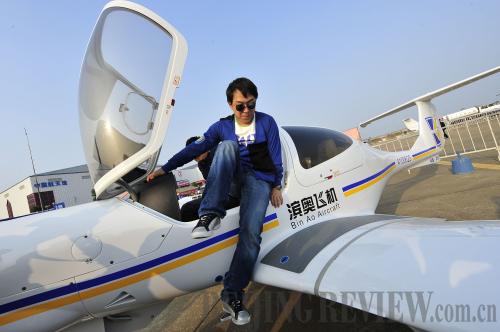|
 |
|
READY FOR TAKEOFF: Actor Huang Bo appears in an advertisement for a pilot training school during the China International Aviation and Aerospace Exhibition held in Zhuhai, Guangdong Province (CFP) |
For international aircraft makers such as Cessna, Gulfstream, Dassault and Bombardier that have been trying to develop the general aviation business in China over the past decade, there is now cause to celebrate. An opportunity for them to fully display their prowess is fast approaching and their investment will at long last yield rewards.
This opportunity stems from the soon-to-be-released national regulations on the use and management of low-altitude airspace for general aviation. According to a business insider, the regulations will stipulate details on the designation, use and management of low-altitude airspace in China. That means after the new policy is issued, the last hurdle for private jets being able to fly in China's low-altitude airspace will be surmounted.
General aviation can be defined as all civilian flying except scheduled passenger airlines, and low-altitude airspace below 3,000 meters represents the major playground for this type of aviation.
To international aviation companies, China's general aviation market is a treasury in air that has not yet been exploited. Once the restriction is loosened, China will become the fastest growing general aviation market in the world, which will be quite tempting to potential investors.
Four years' preparation
Opening up China's low-altitude airspace has been discussed for more than 10 years, but preparations began only four years ago.
In 2010, the Civil Aviation Administration of China (CAAC) announced guidelines for freeing up low-altitude airspace, setting the goal of opening up airspace below 1,000 meters by 2015 and airspace below 3,000 meters by 2020.
In the same year, another guideline was issued to deepen the reform of low-altitude airspace management. The guideline divides China's airspace into three categories: airspace subject to control, to monitoring and to reports.
Flying in airspace subject to control must be applied for in advance and directed by the air traffic management department. Flying in airspace subject to monitoring only requires the flight to be put on record and a guarantee that the aircraft can be monitored by radar and will be available for radio communication. Aircraft flying in airspace subject to reports need only inform authorities of the time of departure and landing. This is the country's first document on the management of low-altitude airspace, with the aim of preparing for its eventual opening up.
China's low-altitude airspace is divided into seven flight regions, namely Beijing, Shenyang of northeast China's Liaoning Province, Lanzhou of northwest China's Gansu Province, Jinan of east China's Shandong Province, Nanjing of east China's Jiangsu Province, Chengdu of southwest China's Sichuan Province and Guangzhou of south China's Guangdong Province.
In 2011, the CAAC conducted low-altitude flight tests in Shenyang and Guangzhou. With the exception of military areas, private jets in the pilot regions only needed to report their flight plans before 3 p.m. on the day prior to the planned flight. Thus, the year 2011 is referred to as the "first year of China's general aviation."
Since 2012, the pilot project was extended to areas of airspace in all of the other five flight regions.
Based on the experiences of the pilot project, China issued three other documents concerning general aviation development in 2012 and 2013. Particularly according to the provisions on approval and management of general aviation missions issued in 2013, apart from nine types of general aviation missions, all other missions do not need to be approved in advance. This is considered a real stimulant to the general aviation industry. A more feasible policy of opening the low-altitude airspace has hence become possible.
The regulations on the use and management of low-altitude airspace for general aviation have been approved by the State Council, the country's cabinet, and the designation scheme of the country's low-altitude airspace has been intensively prepared. Moreover, construction standards for general aviation airports are expected to be issued in 2014, and detailed low-altitude charts and guidelines on the improvement of the air traffic management system will also be set up in the next one or two years.
| 